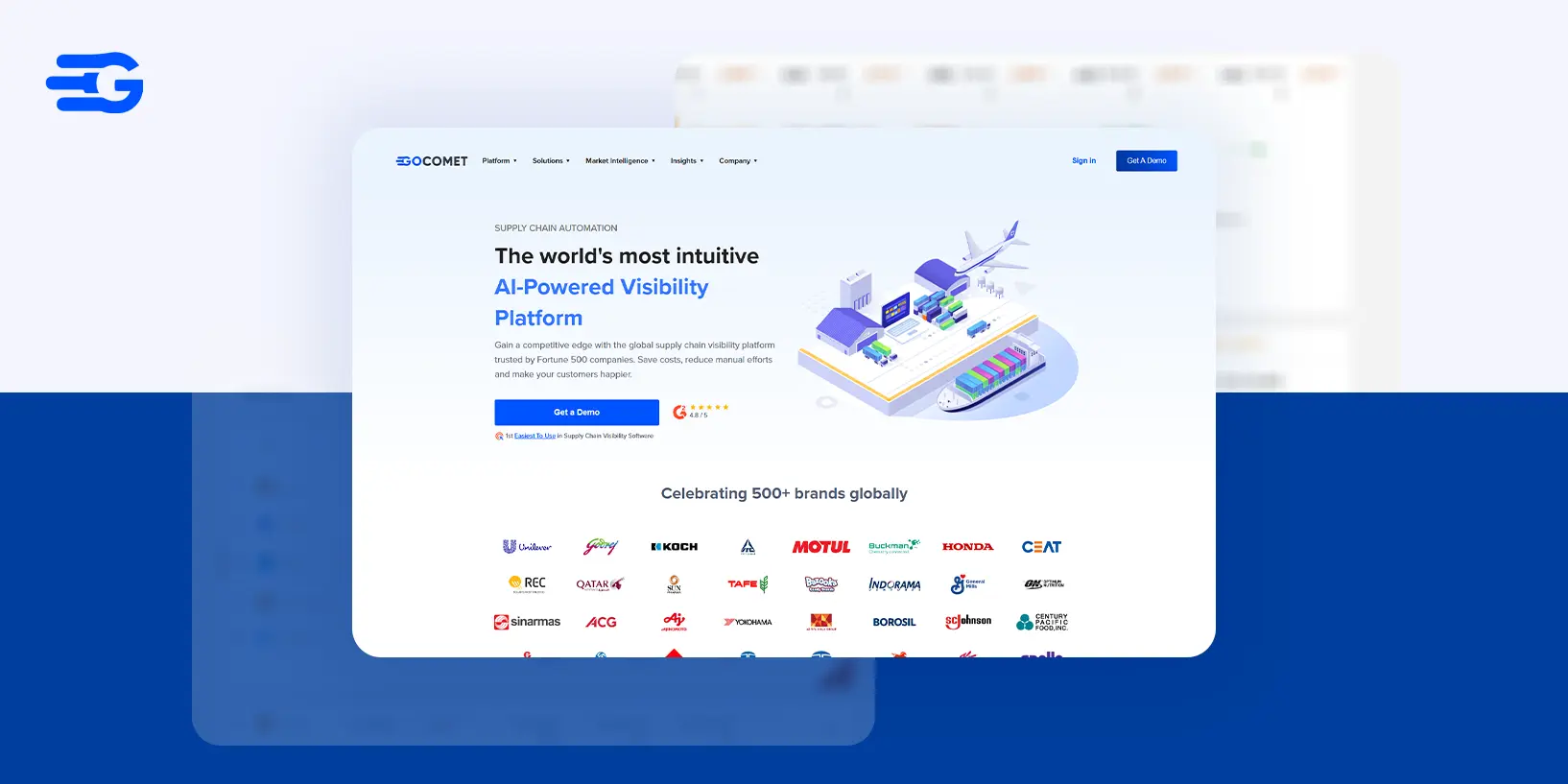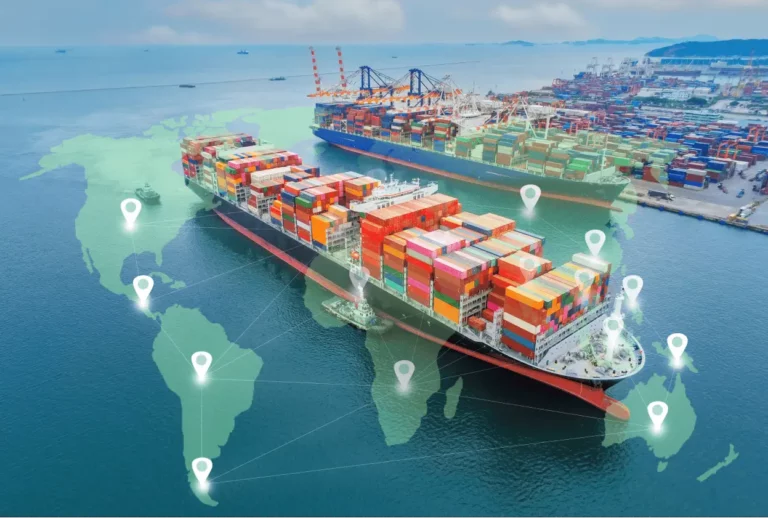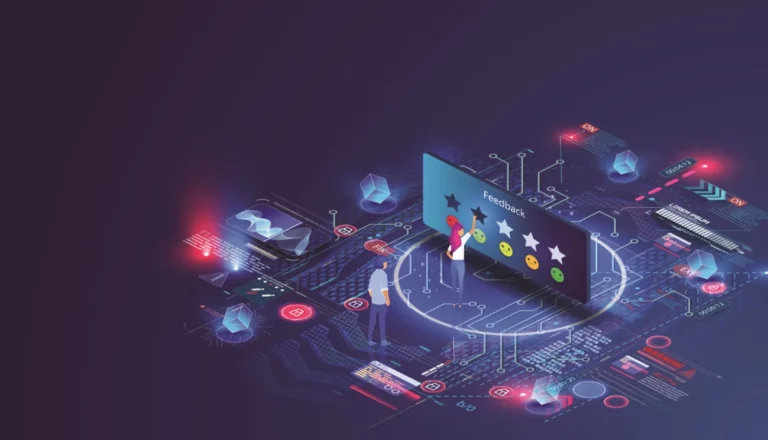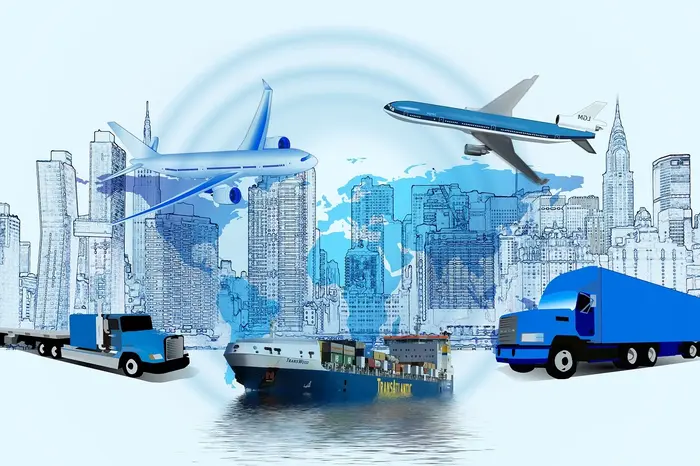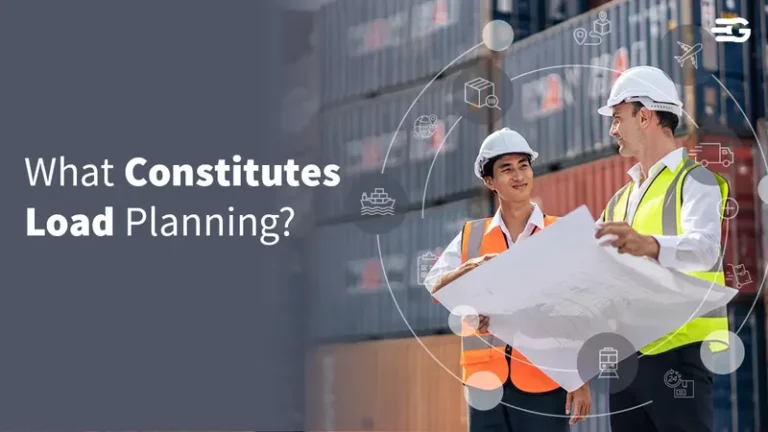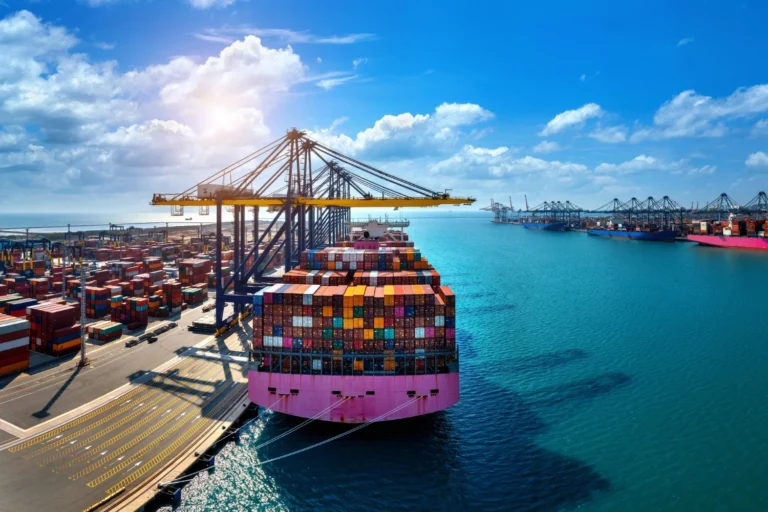Top 12 Logistics Management Solutions In 2025
Managing logistics isn’t just about moving goods from point A to B. It’s a puzzle with countless pieces; shipments, invoices, carriers, delays; you name it. Without the right system, things can spiral out of control fast. That’s where logistics management software steps in. It helps streamline operations, cut costs, and keep everything running like clockwork.
To make your life easier, we’ve rounded up the top logistics management software for 2025 that can help you stay ahead. Let’s dive in.
What Is a Logistics Management Solution?
Think of a logistics platform as the brain behind smooth shipping operations. It helps businesses move goods faster, smarter, and with fewer errors. From tracking shipments to planning efficient routes, it takes the guesswork out of supply chain management.
With the right solution, companies can reduce delays, optimize resources, and keep customers happy. It provides real-time visibility into shipments, inventory, and transportation, ensuring everything runs like clockwork.
For businesses that rely on shipping, this isn’t just a tool; it’s a game changer. It simplifies complex tasks, cuts unnecessary costs, and gives companies complete control over their freight operations.
How to Pick the Right Logistics Software
Choosing the right logistics management solution isn’t just about features; it’s about finding the right fit for your business. Here’s what to look for:
- Scalability: Your business will grow, and your software should keep up. Pick a system that handles increasing shipments, supports multiple locations, and adapts to market shifts. Cloud-based options usually offer the most flexibility.
- Live Shipment Tracking: Visibility is everything. Make sure your software gives you real-time updates on cargo locations, expected arrival times, and potential delays. IoT integration is a bonus, especially for temperature-sensitive or high-value shipments.
- Smart Automation: Manual processes slow things down. Look for features like automated freight booking, rate comparisons, and digital document generation to cut errors and boost efficiency. The best systems streamline workflows instead of adding complexity.
- Easy to Use: No one wants to wrestle with clunky software. An intuitive dashboard, simple navigation, and quick onboarding ensure your team can hit the ground running.
- Reliable Support: Things go wrong; fast support matters. Choose a provider with 24/7 assistance, dedicated account managers, and clear issue resolution protocols to keep operations on track.
- Seamless Integrations: Your ERP, accounting software, and warehouse management system (WMS) should work together, not against each other. Look for APIs and plug-and-play integrations to avoid data silos and manual data entry.
Top Logistics Management Solutions
1. GoComet
GoComet is an AI-powered logistics management solution built for end-to-end visibility and cost optimization. It helps businesses streamline freight procurement, automate tracking, and predict ETAs with accuracy.
With multimodal tracking, automated invoice reconciliation, and real-time rate comparisons, companies gain better control over shipments and reduce unnecessary costs. The platform’s data-driven insights enhance supply chain transparency, making it easier to manage complex logistics operations.
Larger enterprises benefit the most from GoComet’s advanced automation and analytics, while smaller businesses may need some training to maximize its features. However, its intuitive interface and AI-driven recommendations ensure a smooth transition.
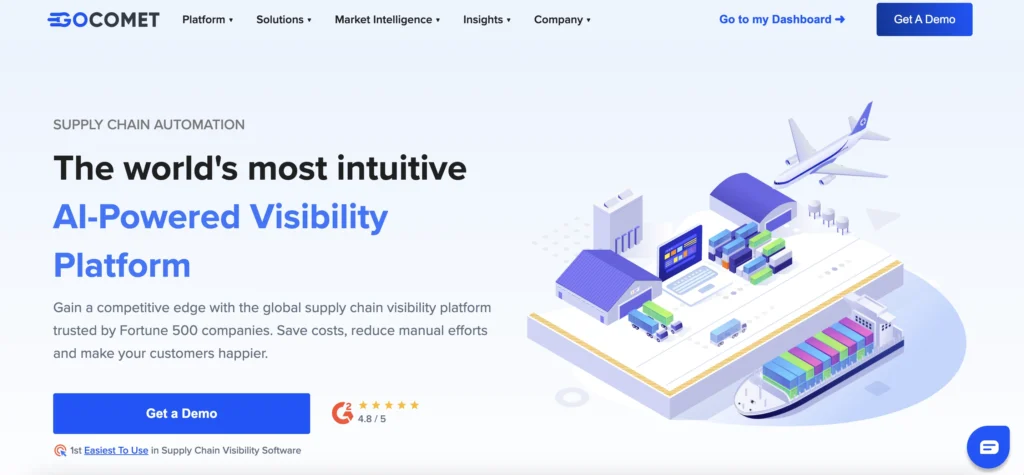
Key Features:
AI-Powered Visibility: Provides end-to-end shipment tracking with real-time updates, predictive ETAs, and instant alerts, ensuring seamless supply chain management.
Cost and Workflow Automation: Automates freight procurement, invoice audits, and finance integration to reduce costs, prevent overpayments, and streamline operations.
Data-Driven Optimization: Utilizes analytics and machine learning to identify bottlenecks, monitor delays, and offer market rates, carrier insights, and port congestion data.
Sustainability and Collaboration: Monitors carbon emissions, provides cloud-based document storage, and enhances teamwork through automated data exchange and workflow tools.
Limitations:
Limited SKU-Level Tracking: Does not fully support detailed tracking at the individual SKU level, which may be challenging for businesses requiring granular visibility.
Ratings (as of May, 2025):
- G2– 4.8/5
- Gartner– 4.9/5
Testimonials:
“GoComet is a fantastic platform. It helped us in optimizing our logistics process. It gives real-time tracking visibility with precise data, automated reports. It helped us in digitizing the entire logistics process and ease out the auditing process.”
2. SAP Logistics
SAP Logistics is a trusted name in supply chain management, offering a comprehensive platform for businesses looking to optimize logistics operations. It helps companies streamline warehouse management, track shipments, and improve order fulfillment.
With robust tools for transportation planning and real-time data analysis, SAP Logistics enables better decision-making and efficiency across supply chains. Businesses benefit from enhanced visibility, improved coordination, and reduced operational bottlenecks.
While SAP Logistics is feature-rich and scalable, it may require significant setup time and expertise to fully leverage its capabilities. However, for enterprises managing complex logistics networks, it remains a powerful solution.
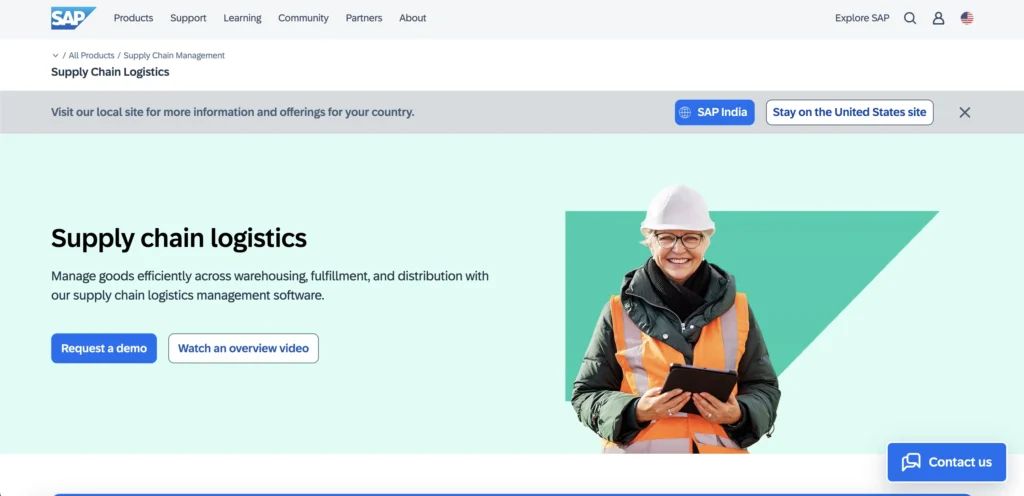
Key Features:
Real-Time Supply Chain Visibility: Provides live updates on shipments, inventory levels, and delivery schedules, enabling businesses to identify delays, anticipate risks, and address bottlenecks promptly.
Integrated Logistics Processes: Unifies warehousing, transportation, and order fulfillment into a single system, reducing errors and accelerating delivery times.
Collaborative Supply Chain Management: Connects businesses with partners across various transportation modes and regions, enhancing operational efficiency and coordination.
Sustainable Operations: Optimizes logistics processes such as shipment planning and inventory management, helping businesses reduce emissions while maintaining high efficiency.
Limitations:
Steep Learning Curve: Users report that mastering SAP requires significant time and extensive training, which can slow initial adoption.
Complex Integration: Setting up and integrating SAP with existing tools can be technically demanding and time-consuming.
Ratings (as of May, 2025):
- G2– 4.4/ 5
- Gartner– 4.3/5
Testimonials:
“Tool is overall good as a standard planning tool, per build a lot of best practices , but lack of AI or the new interesting stuff , fancy user interface /dashboard etc.”
3. Oracle
Oracle offers all-inclusive logistics management solutions designed to provide a comprehensive view of logistics operations. From order processing to final delivery, Oracle supports every stage of the logistics process. Its robust platform ensures seamless integration across supply chain activities, enabling businesses to optimize performance, reduce costs, and enhance customer satisfaction.
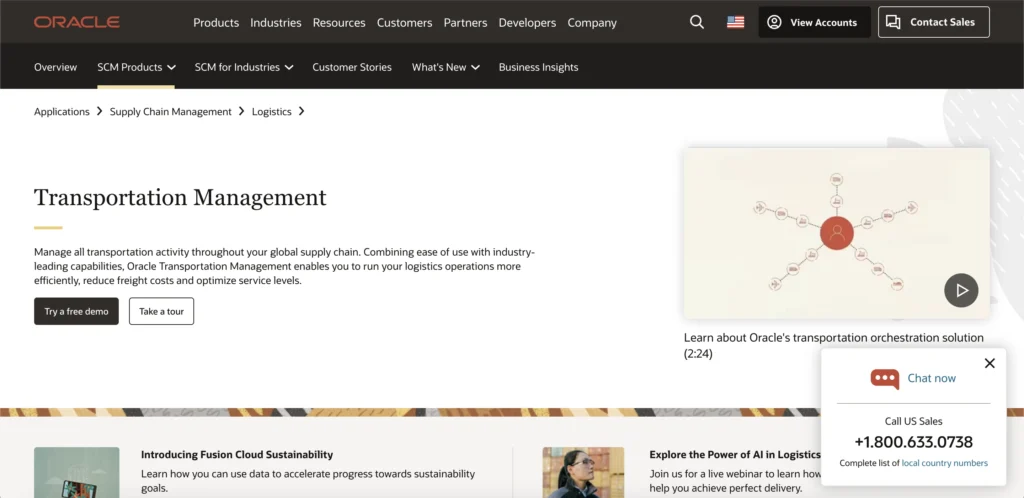
Key Features:
Comprehensive Logistics Planning: Optimizes transportation routes, manages shipments, and streamlines supply chain workflows to reduce costs and improve delivery efficiency.
Automation & Integration: Automates billing, freight audits, and shipment tracking, while integrating seamlessly with ERP, CRM, and WMS systems for smoother operations.
Real-Time Visibility & Analytics: Offers live tracking and performance monitoring, enabling businesses to quickly identify delays and inefficiencies in their logistics network.
AI & Machine Learning Optimization: Utilizes AI-powered predictions for transit times, dynamic resource allocation, and optimized carrier selection for cost-effective transportation.
Limitations:
Integration Challenges: Businesses may face difficulties in creating cross-functional reports and configuring the system to work seamlessly across various operational environments.
Usability Concerns: Some users report a decline in usability, as Oracle’s shift toward cloud-based offerings has yet to fully match the robust functionality of its existing on-premise system.
Ratings (as of May, 2025):
- G2: 4/5
- Gartner: 4.7/5
Testimonials:
“Small scale industries better where they cant offered more money. It will not allow easy customization Oracle SCM Cloud allow only for small scale industries not for Large scale industries.”
4. Magaya
Magaya offers versatile logistics management solutions with freight forwarding, warehouse management, and transportation management tools. It helps businesses streamline shipping processes, reduce costs, and improve delivery efficiency.
With automated workflows and real-time tracking, Magaya simplifies inventory management, customs compliance, and cargo handling. Its user-friendly interface makes it easy for teams to manage shipments, optimize routes, and track deliveries without hassle.
While Magaya is a strong choice for freight forwarders and logistics providers, businesses with highly complex supply chains may need custom integrations to fully leverage its capabilities. However, its automation and visibility features make it a reliable option for companies looking to enhance their logistics operations.
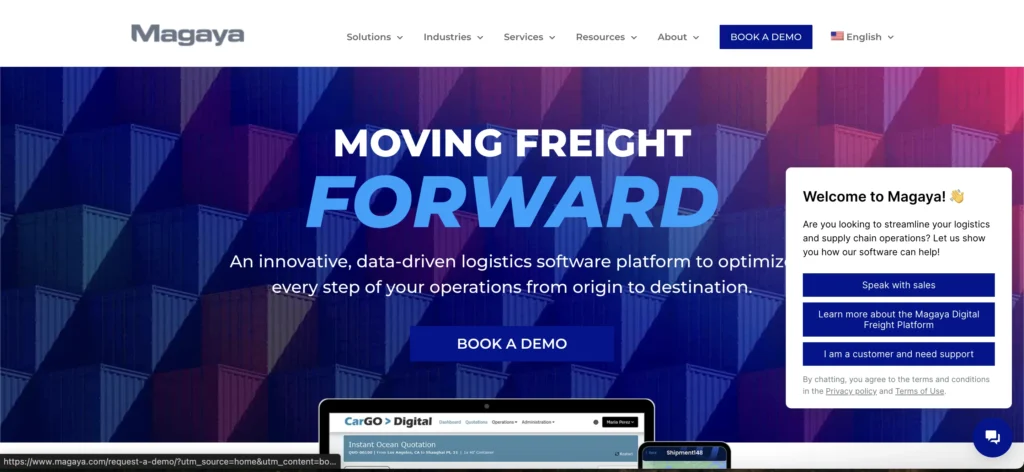
Key Features:
Automation of Manual Tasks: Reduces manual work by automating shipment tracking, document filing, and customer inquiries, minimizing errors and saving time.
Centralized Data Visibility: Provides a single dashboard for monitoring the entire supply chain, ensuring faster decision-making and improved collaboration.
Customer-Centric Self-Service Options: Offers digital tools for customers to track shipments in real-time and access logistics data without delays.
Seamless System Integrations: Connects smoothly with ERP, accounting, and CRM systems, reducing manual data entry and enhancing workflow accuracy.
Limitations:
Limited Customization: Customizing features like adding new fields or adjusting workflows requires technical expertise or external support, making adjustments time-consuming.
Insufficient Automation & Adaptability: Some manual processes remain, and the platform doesn’t easily adapt to rapid changes in global trade regulations, which can slow down efficiency.
Ratings (as of May, 2025):
- G2– 4.4/5
- Garnter– NA
Testimonials:
“Online easy to use, I can custom to my needs in our logistic company. The accounting part in the magaya software, which can not customize to our tax compliance in our country, hope the software can use in iOS platform. The magaya support team advice me to use windows instead iOS.”
5. Descartes Aljex Logistics
Descartes Aljex simplifies transportation management with automated workflows, real-time shipment tracking, and compliance solutions. It helps freight brokers, carriers, and logistics providers optimize operations and reduce manual work.
Its cloud-based platform enables businesses to track shipments, manage dispatching, and monitor carrier performance from a single dashboard. Automated document management ensures smooth compliance with customs regulations.
While Descartes Aljex is a powerful tool for freight management, businesses with unique operational needs may require additional customization. However, its visibility, automation, and compliance tools make it a strong choice for logistics teams looking to improve efficiency.
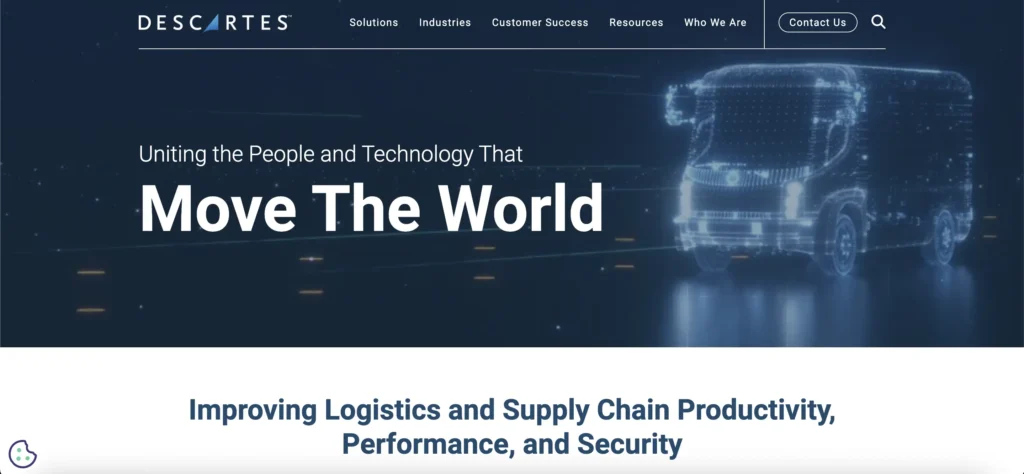
Key Features
Centralized Carrier Management: Consolidates carrier details, rates, and performance metrics in one place, making rate negotiation and selection easier.
Lane Rate Consolidation: Organizes lane rates and shipping cost data, allowing businesses to analyze, compare, and optimize freight expenses.
Smart Load Matching: Uses historical and real-time data to match shipments with the best carriers, improving route planning and cost efficiency.
Invoicing & Advanced Reporting: Simplifies invoice management and financial tracking, providing real-time insights for better decision-making.
Limitations:
Limited Bulk Load Duplication: Users cannot duplicate multiple loads at once, leading to time-consuming manual data entry. A bulk duplication feature would improve efficiency.
Cluttered Interface with Excessive Tabs: The platform has too many tabs, making navigation overwhelming. A more intuitive layout would enhance usability.
Ratings (as of May, 2025):
- G2: 4.6/5
- Gartner: 4.0/5
Testimonials:
“Its precise and fast to understand, You can track the shippment. Interface can be adjusted to be more user friendly. I wish I could duplicate multiple loads at once instead of just one at a time. If this could be changed, it would help me save time when entering loads into the system.”
6. MercuryGate – Efficient and User-Friendly
MercuryGate helps businesses take full control of their transportation operations through an intuitive, all-in-one platform. It offers real-time tracking, performance analytics, and automated workflows to streamline logistics processes.
One of its biggest strengths is its ability to handle multimodal transportation; whether it’s air, ocean, rail, or road, MercuryGate ensures seamless coordination across different carriers. The platform’s AI-powered insights help businesses make faster, data-driven decisions and optimize their supply chain costs.
While MercuryGate is feature-rich, new users might face a learning curve. However, its scalability, automation, and real-time analytics make it an excellent choice for companies managing complex transportation networks.
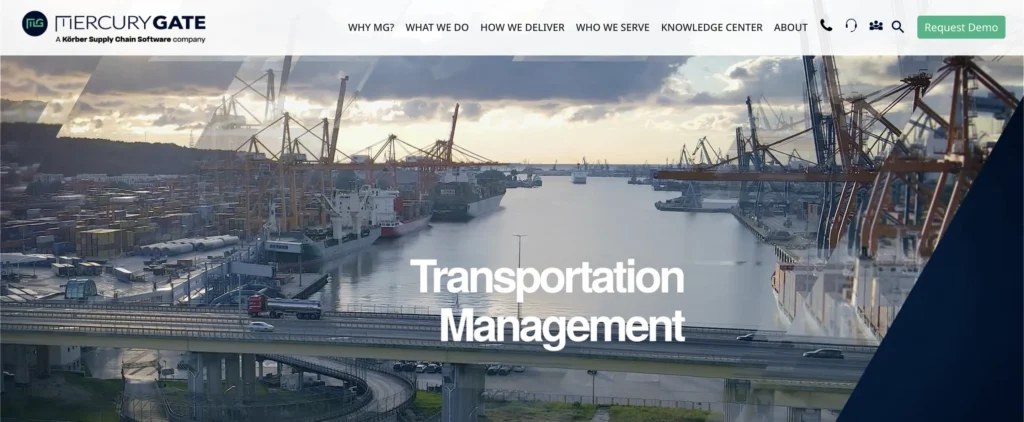
Key Features
Freight Claims Management: Automates freight claims processing, reducing manual effort and speeding up revenue recovery from lost or damaged shipments.
Final Mile Routing & Scheduling: Enhances delivery efficiency by optimizing routes and schedules from the first mile to the last mile, reducing time and costs.
Multimodal Optimization: Enables businesses to seamlessly plan shipments across multiple transportation modes, cutting costs and lowering carbon emissions.
Customs & Trade Compliance Automation: Automates customs clearance across multiple agencies, reducing delays and keeping shipments moving smoothly.
Limitations:
Complex Customization & Outdated UI: While highly customizable, the legacy interface is difficult to navigate, requiring steep learning curves for new users.
Limited Integration Capabilities: Weak ERP and WMS integration and a lack of open API support make it difficult to connect with modern logistics systems.
Ratings (as of May, 2025):
- G2– 4.0/5
- Gartner– 4.4/5
Testimonials:
“Mercury Gate does well at its core functions and has a great support team to assist system problems and implementations. Mercury Gate does not do well to support with any custom feature or requests.”
7. Kuebix
Kuebix helps businesses optimize freight operations while keeping costs under control. It offers real-time tracking, route planning, and carrier management to ensure smoother deliveries.
One of its standout features is carrier rate comparison, allowing companies to evaluate costs and service quality across multiple providers before making a decision. This ensures better cost efficiency and smarter logistics planning.
Kuebix is particularly useful for shippers managing high shipment volumes. While it provides powerful tools for freight optimization, smaller businesses might find its advanced features more than they need. However, for enterprises handling complex logistics operations, Kuebix brings efficiency, transparency, and cost savings.
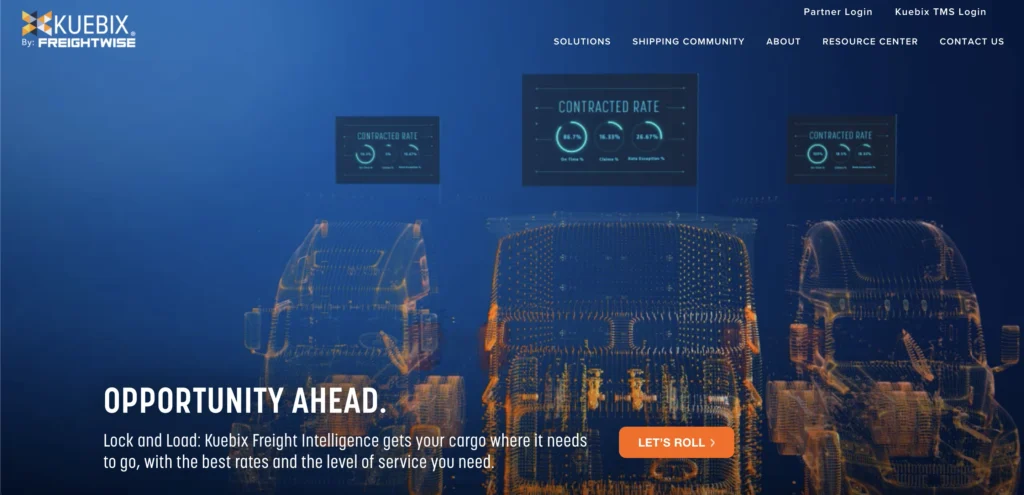
Key Features:
Diverse Shipping Modes: Supports LTL, Full Truckload, Parcel, and Intermodal shipments, giving businesses flexibility in choosing the best transportation mode.
Seamless Carrier Integration: Connects with major carriers via API and EDI, ensuring real-time data sharing, faster setup, and improved shipment coordination.
Enhanced Visibility & Analytics: Provides real-time tracking and in-depth reporting tools, enabling businesses to monitor key performance metrics and optimize logistics strategies.
Proven Industry Leadership: Trusted by leading brands like Ahold USA, Kuebix delivers competitive advantages through innovation and expertise in logistics management.
Limitations:
Limited Reporting Access: Users report restricted access to custom data reports, requiring additional costs for advanced analytics.
Integration & Feature Challenges: Some users face delays in resolving integration issues and find multi-pick/multi-drop customization lacking, along with missing auto-flagging for oversized shipments.
Ratings (as of May, 2025):
- G2: NA
- Gartner: 4.6/5
Testimonials:
“Easy rate quote layout but lack of rate quote history reports that other TMS platforms offer. Also had conflicting pick up requests sent.”
8. FreightPOP
FreightPOP provides businesses with a single platform to manage freight and parcel shipments seamlessly. Whether it’s LTL, FTL, air, ocean, or rail, this software ensures smooth coordination across multiple shipping modes.
With real-time rate comparisons, shipment tracking, and automation, FreightPOP helps companies cut costs and improve delivery efficiency. Its integration capabilities make it easy to connect with existing ERP, WMS, and TMS systems, eliminating the hassle of manual data entry.
FreightPOP is ideal for businesses looking to simplify logistics without compromising control. While it offers powerful features, companies with highly customized logistics needs may require additional configuration to maximize its benefits.
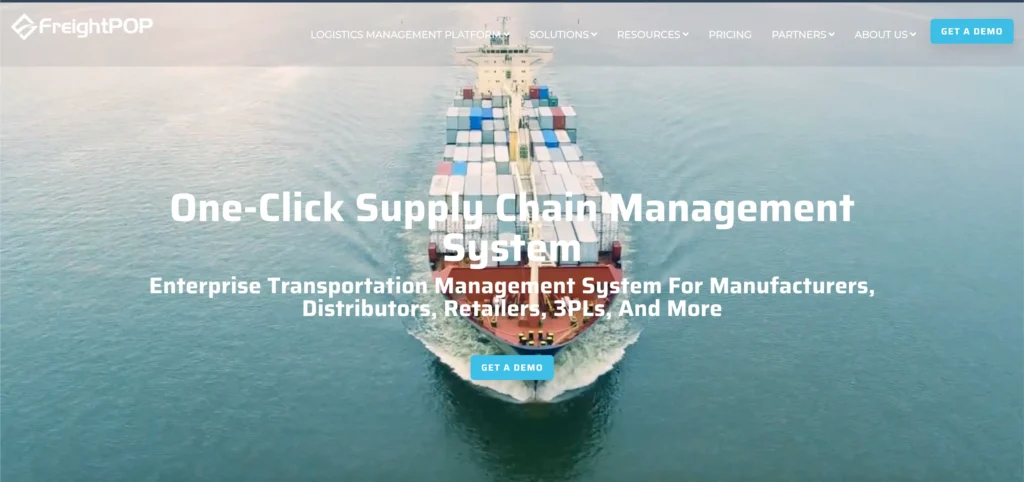
Key Features:
Unified Shipping Platform: Manage planning, tracking, reporting, and billing for LTL, FTL, Parcel, Ocean, Rail, and Air; all in one system.
Real-Time Shipment Visibility: Track shipments globally in real time while detecting billing errors to streamline payments and reduce overcharges.
Actionable Analytics: Uses Microsoft Power BI to provide predictive insights, cost optimization, and carrier performance tracking for better decision-making.
Flexible and Integrative Setup: Supports 1,500+ integrations, including ERP, CRM, and accounting tools, with easy implementation and no long-term contracts.
Limitations:
Integration Gaps with Certain Platforms: Does not support integration with some systems like Epicor Kinetics, which may limit usability for businesses reliant on specific tools.
Unpolished Interface & Tracking Delays: The user interface feels outdated, and shipment tracking updates aren’t always instant, causing occasional monitoring delays.
Ratings (as of May, 2025):
- G2: 4.8/5
- Gartner: NA
Testimonials:
“The software just works. They have fabulous tech support. Wish they would have had an interface into Epicor Kinetics.”
9. Manhattan Associates
Manhattan Associates offers a cloud-native logistics management solution designed to enhance efficiency across supply chains. With real-time route optimization, carrier management, and fleet resource allocation, businesses can reduce costs and improve delivery accuracy.
Its scalable and flexible architecture makes it ideal for growing enterprises that need a system capable of adapting to increasing shipment volumes. The platform also integrates seamlessly with ERP and warehouse management systems, ensuring smooth data flow across operations.
While Manhattan Associates excels in advanced logistics planning, businesses with simpler transportation needs may find its extensive features more than they require.
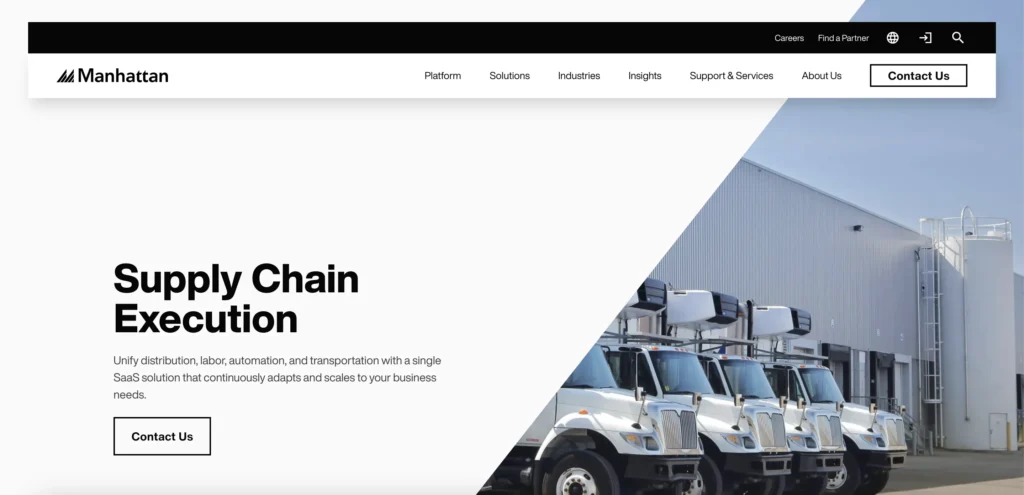
Key Features:
Dynamic Optimization: Continuously updates routes and delivery plans based on real-time data like traffic, weather, and demand changes to improve efficiency.
Interactive Network Visualization: Provides real-time maps, dashboards, and analytics tools for complete transportation network visibility in one place.
Scenario Testing & Decision Support: Enables businesses to simulate multiple logistics scenarios, evaluate potential outcomes, and make smarter strategic decisions.
Fleet & Resource Management: Optimizes the allocation of drivers, vehicles, and resources, ensuring balanced workloads, regulatory compliance, and lower costs.
Limitations:
Slow Optimization for Small Shippers: Smaller businesses may experience slow optimization run times due to the system’s complexity and high processing requirements.
Integration Issues: Some users report mapping discrepancies and incomplete integrations with courier services, which can cause operational disruptions.
Ratings (as of May, 2025):
- G2: 4.6/5
- Gartner: 3.4/5
Testimonials:
“Three years after the start of implementation, the TMS still does not meet requiremente for dinamic routing and invoice auditing.”
10. E2open
E2open is a cloud-based logistics management platform that connects businesses, suppliers, and customers for seamless supply chain collaboration. It offers solutions for demand planning, transportation management, and inventory optimization, helping companies reduce costs and enhance visibility.
With AI-powered analytics and real-time shipment tracking, E2open enables businesses to anticipate disruptions, optimize routes, and streamline decision-making. Its integrated ecosystem ensures that every stakeholder stays informed, reducing delays and boosting efficiency.
For companies seeking a data-driven approach to logistics, E2open provides smart automation and predictive insights to keep supply chains agile and responsive.
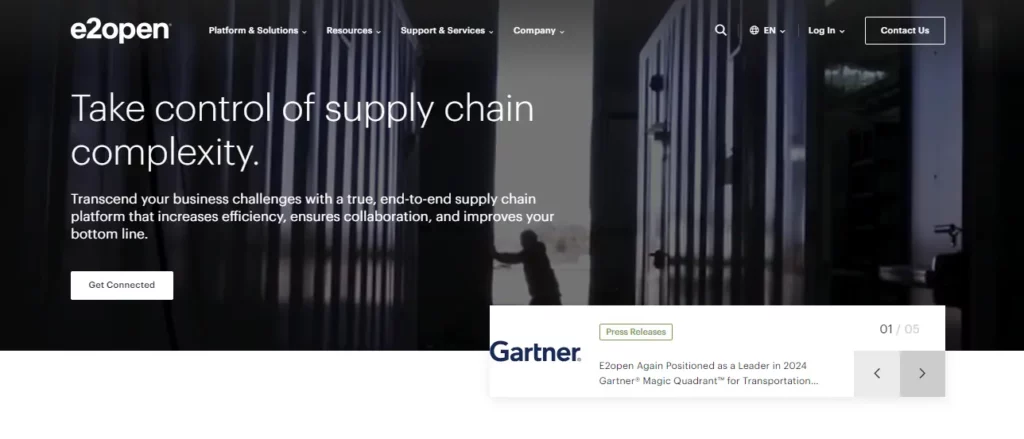
Key Features:
Collaborative Network: Connects businesses with 480,000+ manufacturers, distributors, and logistics providers, enabling seamless supply chain coordination.
Predictive ETAs: Uses AI-driven insights to anticipate delivery times, helping businesses optimize logistics planning and reduce delays.
Cost Optimization: Compares carrier invoices, automates contract management, and helps reduce freight costs, ensuring better budget control.
Real-Time Shipment Tracking: Offers end-to-end visibility across all shipments, allowing businesses to track goods in transit and respond to disruptions quickly.
Limitations:
Limited Integration with Other Software: Not all ERP or TMS platforms integrate seamlessly, which can cause data silos and slower workflows.
Limited Shipping Modes: Currently supports only road and rail transportation, excluding ocean and air freight, which may restrict global logistics operations.
Ratings (as of May, 2025):
- G2: 4.1/5
- Gartner: 4.3/5
Testimonials:
“Huge network amongst the shipping fraternity. Customer care service can be bit slow at times.”
11. CargoWise
CargoWise is a powerful logistics platform built for freight forwarders, customs brokers, and 3PL providers. It automates operations with features like real-time shipment tracking, customs compliance, and warehouse management, ensuring smoother workflows and fewer delays.
The cloud-based system makes integration seamless, allowing teams to collaborate efficiently while managing global supply chain operations. With automated documentation, advanced reporting, and multi-modal support, CargoWise helps businesses reduce errors, stay compliant, and optimize logistics costs.
For companies handling high shipment volumes, CargoWise offers the scalability and automation needed to stay ahead in a fast-moving industry.
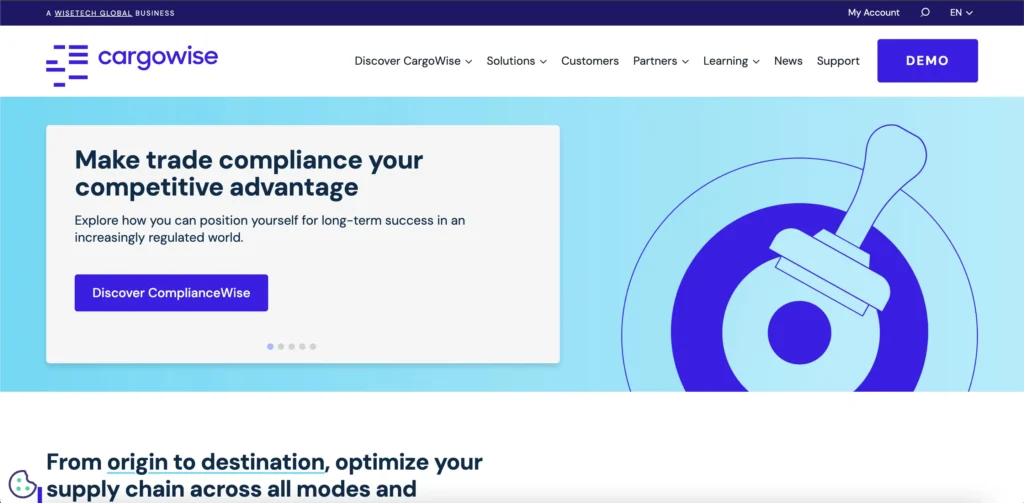
Key Features:
Real-Time Tracking: Provides live shipment updates, helping businesses monitor cargo status and address delays quickly.
Customs Compliance: Automates customs documentation and regulatory requirements, ensuring faster border clearance and reducing compliance risks.
Cloud-Based Integration: Enables teams to collaborate from anywhere, connecting TMS, ERP, and other platforms seamlessly.
Advanced Reporting: Delivers detailed analytics and insights to optimize supply chain performance and enhance decision-making.
Limitations:
Difficult Customization: Customizing the software requires technical expertise, making it time-consuming and complex.
Frequent System Bugs: Users report occasional crashes and glitches, which can disrupt workflows and slow down operations.
Ratings:
- G2: 3.2/5
- Gartner: 4.3/5
Testimonials (as of May, 2025):
“It’s easy to use, and the platform has different tools to facilitate the experience. Sometimes the app disconnects instantly, becouse when this happen the info don’t save.”
12. ShipStation
ShipStation makes e-commerce shipping simple by integrating with multiple carriers, marketplaces, and shopping carts. It automates order management, label printing, and real-time tracking, helping businesses save time and reduce errors.
With smart automation tools, ShipStation handles repetitive shipping tasks, ensuring faster processing and accurate deliveries. The platform also provides detailed analytics, allowing businesses to track costs, monitor performance, and optimize shipping strategies.
For online retailers and fulfillment centers, ShipStation is a cost-effective, easy-to-use solution that keeps shipping fast, efficient, and hassle-free.
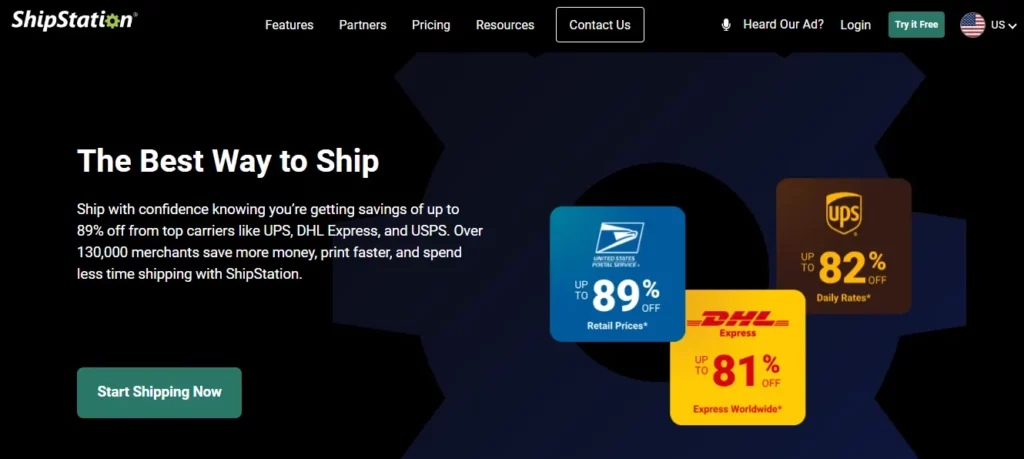
Key Features:
Pre-Negotiated Shipping Rates: Access discounted rates with major carriers to cut down shipping costs.
Marketplace & Platform Integration: Seamlessly connects with 40+ carriers, e-commerce platforms, and marketplaces for a smooth shipping workflow.
Automatic Cost Optimization: The system selects the most cost-effective carrier service for each shipment, minimizing manual effort.
Limitations:
Inconsistent Customer Support: Many users report frustration with bot-based support, making complex issues difficult to resolve.
Complicated Login Process: The multi-step login (sometimes requiring 30+ clicks) creates unnecessary delays for daily users.
Ratings (as of May, 2025):
- G2: 4.3/5
- Gartner: NA
Testimonials:
“Shipstation makes it super simple for users to manage thousands of parcels every day. Support is mostly out of hours and when the system goes down, theres not much you can do but wait.”
Conclusion
Selecting the right logistics management software is essential for improving operations, reducing costs, and staying competitive. Focus on your unique needs and ensure the software aligns with your goals. With tools like real-time tracking, automation, and scalability, the right choice will enhance efficiency and drive growth.
FAQs
Which software is best for logistics?
The best logistics software depends on your business needs. However, software like GoComet offers a robust suite of tools for shipment tracking, route optimization, and supply chain visibility, making it ideal for businesses with large shipments.
What are the 7 functions of logistics management?
The 7 key functions of logistics management include:
- Transportation: Moving goods from one location to another.
- Inventory Management: Ensuring the right stock is available at the right time.
- Warehousing: Storing goods in an organized and accessible way.
- Order Fulfillment: Managing customer orders from start to finish.
- Packaging: Ensuring goods are packed securely for transport.
- Supply Chain Management: Coordinating with suppliers and partners.
- Information Management: Monitoring and analyzing logistics data for better decision-making.
How does logistics management software improve efficiency?
Logistics management software streamlines operations by automating tasks such as tracking shipments, managing inventory, and optimizing routes. This reduces manual errors, cuts costs, and improves on-time delivery.
Why is logistics management important for businesses?
Efficient logistics management is crucial for reducing costs and ensuring timely deliveries. By optimizing routes, tracking inventory, and managing supply chains effectively, businesses can improve customer satisfaction and boost profitability.
What is the role of technology in logistics management?
Technology plays a significant role in logistics management by automating routine tasks and providing real-time data. With advanced logistics management solutions, businesses can improve tracking accuracy, streamline operations, and make better-informed decisions.
